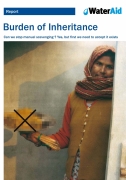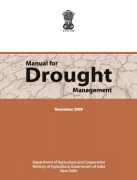/sub-categories/news-and-articles
News and Articles
Water Policy in India - A brief overview: A paper by Centre for Public Policy (IIM Bangalore)
Posted on 20 Apr, 2010 06:30 AMThis paper by the Centre for Public Policy (CPP) of the Indian Institute of Management (IIM) Bangalore adds to the debate on water policy in India, and provides a general overview of the main characteristics of irrigation development post-Independence and a review of its beneficial and adverse impacts. The problems that need to be addressed and measures needed to resolve them are highlighted. It recognizes the vital role of expansion of irrigation in transforming agriculture from one of near stagnation in the pre-independence period to one of sustained growth during the past five decades.
Estimation of replenishable groundwater resources of India and their status of utilization - A research paper by CGWB
Posted on 19 Apr, 2010 09:49 PMThe paper describes the methodology used in the groundwater resource estimation and the results of the latest country-wide assessment. In India, dynamic groundwater resources are estimated jointly by the Central Ground Water Board (CGWB) and State governments at periodic intervals. The latest estimates of dynamic resources are based on groundwater resource estimation methodology-1997 (commonly known as GEC-1997). These estimations are widely used in formulating various groundwater development and management plans. The paper also discusses future strategies on groundwater resource estimations.
Rainwater harvesting in Mumbai: Application of GIS
Posted on 19 Apr, 2010 07:36 PMThis blog post by Prakash Apte, draws attention to the increasing water demand in urban areas because of industrialisation and population growth by giving the example of Mumbai and points at the current scenario of the lack of availability of adequate and safe water supply to meet the needs of the ever increasing population in the city.
The author proposes that rainwater harvesting can be a viable solution in cities such as Mumbai to meet this increasing demand for water and can provide an opportunity for equitable, efficient and sustainable use of water resources.
There is an urgent need for evolving a rainwater harvesting system that is sustainable, replicable and economically viable and argues that the benefits of using rainwater harvesting can lead to a range of social, economic and environmental benefits and can contribute substantially to improving the quality of life in Mumbai.
Geographic Information Systems (GIS) has a role and application, in promoting a system and methodology for rain water harvesting and for providing the data needed to enable its large scale implementation in the context of Mumbai.
Local catchment management in cities - A guidebook by UN-HABITAT
Posted on 19 Apr, 2010 05:02 PM This guidebook by UN-HABITAT, provides an overview of the principles and practices required for sustainable urban water catchment management. It deals with the principles and practices for better management of water resources which, in turn, will lead to general improvement in the health of the local population, food security, environmental protection and sustainable development. It states that it is necessary to develop enduring partnerships among the participating institutions and organizations in the catchment area.
This guidebook by UN-HABITAT, provides an overview of the principles and practices required for sustainable urban water catchment management. It deals with the principles and practices for better management of water resources which, in turn, will lead to general improvement in the health of the local population, food security, environmental protection and sustainable development. It states that it is necessary to develop enduring partnerships among the participating institutions and organizations in the catchment area.
Along side, policies, laws and regulations should be geared to provide an enabling framework as needed for formulation and implementation of action plans at the local level. The guidebook also comprises case studies from Australia, India, Latin America and South Africa to showcase the prospects of local action for water resources management.
Burden of Inheritance: Can we stop manual scavenging? – A report by WaterAid India
Posted on 19 Apr, 2010 04:28 PM This report by WaterAid outlines how over one million people in the country continue to scrape an existence through manual scavenging, forced largely by social convention and caste prejudice, and calls for strong action to eradicate this practice.
This report by WaterAid outlines how over one million people in the country continue to scrape an existence through manual scavenging, forced largely by social convention and caste prejudice, and calls for strong action to eradicate this practice.
A violation of human rights, this discriminatory and demeaning practice was outlawed by the Indian Parliament in 1993 but still continues today. India has missed three deadlines to make the country 'manual-scavenger free'. India's booming cities help keep the practice alive, as there is often little infrastructure for sanitary sewerage and waste disposal systems.
The report tries to seek answers to why this practice continues despite:
- Availability of other dignified livelihood sources, for the people in this occupation?
- Other cleaner options for survival existing in cities and towns?
- Feasible and viable technological alternatives being available to dry toilets, one of the drivers of this occupation?
Pipeline distribution of water : A concept
Posted on 17 Apr, 2010 12:20 AMThe word Water is is sufficient to fulfill the thirst as well as enough power to be drowned away the entire universe.
Sustainable groundwater development through integrated watershed management for food security - A research report by ICRISAT
Posted on 15 Apr, 2010 04:45 PMThis paper by ICRISAT discusses the results from on-farm community watersheds through groundwater management as the drivers for sustainable management of watersheds in dry land areas. The issues of sustainable development and management of the groundwater resource through integrated watershed management (IWM) approach are also dealt with, in the context of food production and security.
Manual on drought management by the National Institute Disaster Management and the Ministry of Agriculture (2009)
Posted on 15 Apr, 2010 04:13 PM This manual developed by the National Institute of Disaster Management (NIDM) presents a comprehensive approach to drought management and recommends measures that can be implemented for effective drought relief and mitigation. It brings together conceptual issues, institutional framework & operational details, and replaces the colonial famine codes written largely for dealing with hunger and starvation.
This manual developed by the National Institute of Disaster Management (NIDM) presents a comprehensive approach to drought management and recommends measures that can be implemented for effective drought relief and mitigation. It brings together conceptual issues, institutional framework & operational details, and replaces the colonial famine codes written largely for dealing with hunger and starvation.
It has been prepared with the objective of creating synergy between the various programmes being implemented to provide drought relief and mitigation by several levels of government.
The key issues covered in the manual are:
State-level utilization of funds and assets created through Ganga Action Plan - Report by Planning Commission for the Supreme Court (2009)
Posted on 15 Apr, 2010 03:41 PMThe report was prepared by the Water Resources Division, Planning Commission in response to a Supreme Court directive to verify whether the funds allocated to Ganga Action Plan (GAP) had been duly utilized by the States. The report is based on data obtained from Central Pollution Control Board (CPCB) and Ministry of Environment and Forests (MoEF) and field visits made to plant sites in Uttarakhand, Bihar and Uttar Pradesh.
Solar water heaters in India: Market assessment studies and surveys for different sectors and demand segments by Greentech Knowledge Solutions
Posted on 15 Apr, 2010 11:12 AM The report endeavors to study the Solar Water Heater (SWH) market in India and project a realizable demand till 2022. It looks at the industry structure, supply conditions and value proposition. It relies heavily on interactions with a wide range of stakeholders, such as SWH users, potential SWH users, state level renewable energy development agencies, architects and builders, banks, municipal corporations, electricity distribution companies and pollution control boards.
The report endeavors to study the Solar Water Heater (SWH) market in India and project a realizable demand till 2022. It looks at the industry structure, supply conditions and value proposition. It relies heavily on interactions with a wide range of stakeholders, such as SWH users, potential SWH users, state level renewable energy development agencies, architects and builders, banks, municipal corporations, electricity distribution companies and pollution control boards.